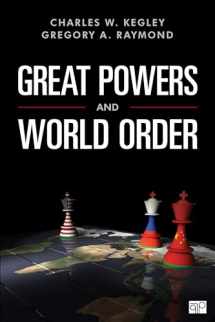
Great Powers and World Order: Patterns and Prospects
ISBN-13:
9781544345833
ISBN-10:
1544345836
Edition:
1
Author:
Charles W. Kegley, Gregory A. Raymond
Publication date:
2020
Publisher:
CQ Press
Format:
Paperback
264 pages
Category:
International & World Politics
,
Politics & Government
FREE US shipping
Book details
ISBN-13:
9781544345833
ISBN-10:
1544345836
Edition:
1
Author:
Charles W. Kegley, Gregory A. Raymond
Publication date:
2020
Publisher:
CQ Press
Format:
Paperback
264 pages
Category:
International & World Politics
,
Politics & Government
Summary
Great Powers and World Order: Patterns and Prospects (ISBN-13: 9781544345833 and ISBN-10: 1544345836), written by authors
Charles W. Kegley, Gregory A. Raymond, was published by CQ Press in 2020.
With an overall rating of 3.8 stars, it's a notable title among other
International & World Politics
(Politics & Government) books. You can easily purchase or rent Great Powers and World Order: Patterns and Prospects (Paperback) from BooksRun,
along with many other new and used
International & World Politics
books
and textbooks.
And, if you're looking to sell your copy, our current buyback offer is $6.33.
Description
Great Powers and World Order encourages critical thinking about the nature of world order by presenting the historical information and theoretical concepts needed to make projections about the global future. Charles W. Kegley and Gregory Raymond ask students to compare retrospective cases and formulate their own hypotheses about not only the causes of war, but also the consequences of peace settlements. Historical case studies open a window to see what strategies for constructing world order were tried before, why one course of action was chosen over another, and how things turned out. By moving back and forth in each case study between history and theory, rather than treating them as separate topics, the authors hope to situate the assumptions, causal claims, and policy prescriptions of different schools of thought within the temporal domains in which they took root, giving the reader a better sense of why policy makers embraced a particular view of world order instead of an alternative vision.


We would LOVE it if you could help us and other readers by reviewing the book
Book review

Congratulations! We have received your book review.
{user}
{createdAt}
by {truncated_author}


